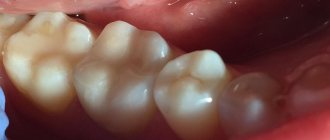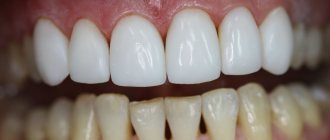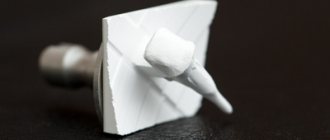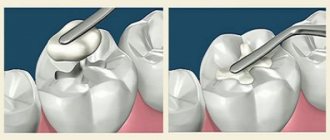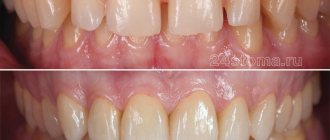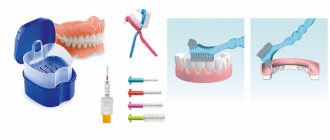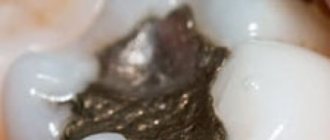Temporary fixation technology
At the preparatory stage, the surgical field and orthopedic structures that are to be fixed are dried and isolated from saliva. Degreasing of working surfaces is not required. Temporary cement is mixed taking into account the manufacturer's recommendations. In the future, the fixation technique - using the example of temporary acrylic crowns on eugenol-free cement - looks like this.
- Temporary cement is applied with a spatula to the cervical part of the temporary crown.
- Under bite control in habitual or central occlusion, the orthopedic structure is fixed in the oral cavity.
- After the time specified by the manufacturer, the temporary cement is removed.
- If work is carried out in support of a dental implant, a rubber dam is used to protect the latter.
- The final stage is x-ray control to check the effectiveness of cement removal.
- Fixation is completed by control of occlusal contacts.
- The patient receives recommendations on the rules for caring for the structure (they are practically no different from the case of installing fixed structures on permanent cement, with the exception of replacing dental floss with a dental brush).
Why are temporary crowns needed?
Before installing a permanent crown on an implant - metal ceramics, ceramics or zirconium dioxide - it is necessary to wait for complete healing and osseointegration. If the initial installation of implants went without problems, then fix a temporary crown
:
The approach is justified from the point of view of aesthetics and functionality - the patient will be able to chew within a few days after the intervention. And after 4-6 months, the temporary crowns will be replaced by beautiful permanent structures
:
Such crowns are made from light, neutral medical polymers. The structures do not complicate the engraftment process. Not stable in use. But the period of their use is 3-6 months, and they do not require special endurance.
When the doctor is convinced that the titanium screw has taken root and there are no inflammatory processes, they are replaced with permanent structures.
The price of a temporary crown for an implant is low (from 9,900 rubles for 1 unit) and will not be ruinous for the patient’s budget, but the prosthesis will provide absolute convenience for the entire recovery period.
Fixing permanent crowns on implants is acceptable, but highly undesirable. With a temporary lightweight option, the load will be gentle. It is easy to dismantle if there is any suspicion that the process has not gone according to plan.
Operational characteristics
The degree of fixation depends on the characteristics of the temporary cement. One of its important properties is the retention force, which allows you to hold the structure and remove it if necessary. The optimal characteristics of temporary cements include:
- good adhesion of indirect restoration;
- ease of mixing and application;
- ease of removal after fixation of cement residues from prepared structures and outer surfaces of the crown;
- adequate working hours;
- optimal viscosity for comfortable use;
- easy removal of the structure without damaging nearby tissues;
- biocompatibility with abutment tooth structures and soft tissues;
- long shelf life;
- no effect on the adhesion of permanent cement.
To identify and remove excess cement, it must be radiopaque. Today, none of the temporary cements on the market have absolutely all of the above properties. It is advisable to use each of them for a specific purpose due to the lack of a single universal solution.
What is the service life of different types of crowns?
As you know, any structure has a certain service life. Unnecessarily long use can lead to dire consequences.
So: how often should crowns be replaced?
It is believed that the average service life of a crown is 5-7 years. At one time, scientists proved that it is after such a period of time that the cement on which the crown is fixed begins to undergo changes. But this does not mean that the crown must be changed every 5 or 7 years. During this period, a doctor should evaluate it to understand whether it can still serve or whether the crown needs to be replaced.
In addition to the duration of use, during a preventive examination, the doctor evaluates the following parameters: the quality of the marginal fit of the crown to the tooth, the condition of the gums and bone tissue next to the crown, X-ray data of the tooth, patient complaints, etc.
Complications
Due to temporary fixation, the following complications are possible:
- de-cementing;
- damage to the supporting structure;
- breakage of the orthopedic structure during removal;
- development of gingivitis or peri-implantitis due to insufficient removal of temporary cement from the gingival sulcus.
The most severe complication is peri-implantitis, in the event of which it is necessary to remove the structure as quickly as possible, remove excess cement and carry out anti-inflammatory measures.
Breakage of the prosthesis or supporting structures is possible due to too much retention force of the temporary cement. Most often, temporary crowns made of plastic or composite materials break. Correcting the situation is quite simple - the damage is glued together with plastic or composite right in the office.
When permanent structures are removed, the ceramic veneer often chips, which requires the manufacture of a new denture. Therefore, it is undesirable to fix ceramic or metal-ceramic prostheses with temporary cement. The least common cases in orthopedic dentistry are cases of breakage or fracture of the crown of a tooth and other damage to supporting structures. Also considered quite rare is the case of excessive load on the implant with the development of peri-implantitis.
Crown materials
Temporary crowns can be made from a variety of materials depending on the patient's budget and desired result. The most commonly used materials are plastic and special composites. These materials are sufficiently durable and relatively inexpensive, which is great for short-term wear. Of course, if the patient wishes, the crown can also be ceramic, metal-ceramic, or made of durable zirconium dioxide.
A distinctive feature of plastic products is that they tend to change their original shade due to exposure to food coloring, smoking, etc. Also, plastic is not able to withstand strong pressure during chewing, as a result, chips, cracks may appear, and the crown may even fall out. Due to the porous surface, pathogenic microorganisms can penetrate into the product.
If for some reason plastic is not suitable for the patient or he is allergic to this material, then the doctor may recommend the use of a composite, for example, acrylic. Such crowns are made directly in the patient’s mouth by layer-by-layer application and fixation using a special lamp.
How to care for a temporary crown after installation
The fragility of the temporary crown requires careful handling of it:
- Dental floss should be used carefully,
- do not use excessive force during daily oral care procedures,
- You should avoid chewing gum and other viscous foods,
- it is better to give up solid food,
- It is advisable to reduce the consumption of sweet foods and carbonated drinks (especially coloring ones).
How to use it yourself
Even when using the latest technologies and materials, dentists cannot give a 100% guarantee that the crown will not fall out. And most often this happens unexpectedly, for example, when a person eats hard or overly viscous food.
On this topic
9 reasons for pain under a crown
- Olga Alexandrovna Novikova
- October 2, 2022
You can quickly solve the problem with glue, but it should be used correctly so as not to aggravate the unpleasant situation. The product comes with instructions that must be followed, and, in addition, you need to listen to the advice of professionals:
- If the prosthesis falls out, it must be picked up and carefully cleaned of food, plaque and adhesive residues. You can use a toothbrush during the event. You should not do this above a bathtub or sink to eliminate the risk of its final loss in the drain hole.
- You should brush your teeth, paying attention to the area where the crown came off. You may experience unpleasant sensations, which is understandable - a ground down tooth has increased sensitivity. It is better to use a brush with soft bristles.
- Before gluing, the prosthesis and tooth must be dry; to do this, you can wipe them with a piece of sterile gauze or bandage.
- When the preparatory stage is completed, you can begin to directly return the fallen prosthesis.
- The fixing agent is applied to the surface of the crown, then it is carefully installed in its original place. To do this as accurately as possible, it is recommended to monitor your own actions in the mirror. If it is impossible to perform the procedure yourself, then you can ask for help from family or friends.
- When the orthopedic structure is installed on the ground down tooth, you need to slightly clench your jaws for 2 minutes. This will make it possible to find out whether it has taken the correct position during this period for the glue to dry. But some remedies act faster; you should learn about this from the instructions.
- Using dental floss, you must carefully remove any remaining adhesive from your teeth. This must be done smoothly and carefully so that the prosthesis does not fall out again.
- After this, you should stop eating and drinking for 30-40 minutes.
Features of fixing crowns on cement
Before starting the procedure, hardware diagnostics are prescribed. An X-ray image allows you to verify the correct integration and make the necessary corrections to the configuration before installing the crown. A prerequisite is the removal of excess dental cement, which can cause irritation of the mucous tissues adjacent to the area being restored.
Among the advantages characteristic of cementing are high structural stability, as well as the possibility of using passive fitting technology. Soft tissue support is provided by the abutment - the crown is installed so that its edge is located either at the same level or apical to the gum contour.
How to install an artificial crown on cement
As part of the general algorithm for prosthetics, fixation is the final stage, and provides for the following procedure:
- The prepared abutment is sandblasted with an abrasive machine, resulting in a rough surface.
- The crown, prepared in advance on the basis of an anatomical cast, is tried on the base, excluding discrepancies in fit.
- An adhesive composition is applied to the inner surface of the prosthesis, after which the product is tightly applied to the abutment.
- The finished structure is irradiated with a special lamp, which accelerates the intensity of polymerization of the fixing layer.
- Excess cement that appears during pressing of the crown is carefully removed from the surface.
Loading of the restored unit is allowed within an hour after the procedure, however, on the first day after surgery it is recommended to avoid excessive pressure on the area.
Advantages and disadvantages of technology
The positive aspects that determine the popularity of the technique include:
- There is no need to form an additional hole, which reduces the aesthetics of the finished prosthesis, which is especially important when prosthetics of frontal units;
- Possibility of correcting the fit of the superstructure - flaws in carelessly performed implantation are leveled out by cement fixation, which ensures the correct position of the crown even with axial deviation of the integrated rod;
- The option of primary fitting outside the oral cavity, which increases the accuracy of the connection and eliminates the development of inflammatory processes;
- Maintaining the strength of the connection in the long term.
The only drawback of the technology is the difficulty of dismantling the crown if new problems arise with the restored area. Fitting with cement will require re-manufacturing of the prosthesis, since removing the previous one without disturbing the original configuration is not possible.
Why are such prostheses needed - functions and purpose?
What are temporary crowns needed for, and why are they placed? The manufacture of any permanent dentures requires a certain amount of time – usually three or more days. At the same time, the supporting teeth have already passed the processing stage and do not look quite aesthetically pleasing - after all, they are quite sharply ground. Therefore, if the question arises - why are temporary crowns placed before permanent ones, you need to understand that they serve the following purposes:
- protection of the ground tooth and surrounding gums from mechanical damage: during chewing food or brushing with a toothbrush. Inflammation of the gums or dental “nerve” should not be allowed. It is also necessary to maintain the shape of the support, because the permanent “cap” is made using casts from the support – and if it breaks, you will have to start prosthetics “from scratch”
- protection from external irritants: acids, temperature changes,
- restoration of dental aesthetics,
- restoration of the functionality of the tooth: of course, in this case its “functionality” will be incomplete, because strong chewing pressure can damage the root or implant,
- acceleration of adaptation to a permanent prosthesis,
- normalization and correction of the position of the gums, if such a crown is placed on a newly installed implant.
Only until 15.01 South Korean implant Osstem - from 18,500 rubles.
Hurry up to sign up for a free consultation and lock in promotional prices.
Call now or request a call
Opening hours: 24 hours a day - seven days a week
In what cases is it advisable to install on cement?
- Complete, partial edentia;
- single restoration;
- angulation of implants, during which high aesthetic and functional indicators become impossible;
- several designs with non-parallel mesio-distal or vestibulo-lingual angulation;
- the patient's desire to choose this method himself.
Cement fixation is possible:
- with a height of the upper part of the abutment of 5 mm or more;
- when the height of the attached gum around the structure is at least 3-5 mm;
- if the bone wall volume around the implant neck is at least 2-2.5 mm;
- with a crown-to-body height ratio of at least 1:1.5;
- antagonist teeth are in the correct position.
